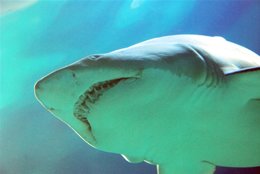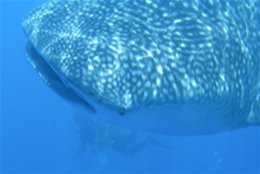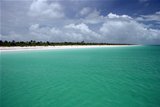The Whale Shark
A Docile Domino
The whale shark has gotten its name for its bus-size dimensions. Unlike whales however, it's not a mammal but a collossal fish, the biggest in the ocean. The largest one measured until now was over 12 meters, but it is believed they can grow up to 18 meters.
The whaleshark also does not match the typical shark profile of a man-eating predator. Lucky for us humans its diet consists of plankton, krill and algae. They are harmless, docile animals.
You can see why on the next two images. Pay attention to the mouth's location and the form of the snout.
 |  |
The Great White has a pointed snout and the mouth is at the rear and on the underside. These mighty jaws are meant to devour! Large fish, seals or anything that gets in its path.
Whale sharks however are 'front-loaders'. Their 1,5 meter wide mouth located at the very front actually makes them look more 'fishy'.
Filter feeders
When they open their formidable mouth they suck up enormous quantities of water. Anything that's in it, like tiny animals, plants and algae, is sieved and gets trapped in the gill rakes. Next they push out the water through five large gill slits on each side of the head. Anything larger than a shrimp gets coughed up.
Also unlike in 'normal' sharks, the two dorsal fins are located away from the head, in the second third of the body. You can recognize young adults by their rear fin. Generally in adolescents the top fin is larger than the lower fin. Adults have a more half-moon shaped fin which they use for propulsion.
The skin of the whale shark is thick and dark-grey in color, with a distinctive pattern of yellow-white dots and lines. These dots are like fingerprints: each individual has its own pattern which can be used for identification.
Researchers take pictures from the skin area around one of the pectoral fins for that purpose. In Spanish the nickname 'domino fish' is used because of this characteristic.
The underside of the animal is white to avoid being seen and attacked from below by some predator.
Baby whale sharks
Not much is known about the mating habits of whalesharks. Apparently they reach maturity at around 30 years of age when they are about 9 meters long. The male fertilizes the female internally with its two claspers. So, umm, they actually have two penisses? Well, yes, I guess they do.
For a long time the whale shark was thought to be oviparous, meaning the pups hatch from eggs outside the mothers womb. However in recent years females have been found to contain hundreds of babies inside their womb. So it's safe then to label them as ovoviparous. The eggs hatch inside the womb and the female gives birth to live young measuring between 40 and 60 cm in length.
Some years ago a female was captured near Taiwan (where they are still hunted) with some 300 fetusses in its womb. Is this a commun birth rate? We can't really tell, and very little is known about the development of the offspring. They can live an estimated 100 years.
Out of season the whale shark stays in warm waters between the tropics of Cancer and Capricorn. They prefer solitude, but some areas are known to attract large quantities. Each year from June through September whalesharks gather in the Yucatan waters near Holbox and Contoy.
Researchers are not totally sure about the reason for this conduct, but obviously the area must be rich in nutrients. Some scientists suggest that the animal is attracted by a particular type of algae. Like there's a big M somewhere out there.
Whale shark tours
On the Yucatan Peninsula organized tours start from the Island of Holbox, Isla Mujeres or Punta Sam (Cancun). Swimming with whalesharks has become increasingly popular, so after twelve years of living here I thought it was time for me to have this breathtaking experience. And breathtaking indeed it was...almost literally!
To protect these endangered animals in their natural environment these are the rules you'll have to observe:
- It is now forbidden to touch the animals. They have a mucous layer on their skin as a protection against infections. By touching them you will affect their natural defenses. Only observing is allowed!
- No diving, life jackets are mandatory, either that or a 4mm wetsuit as an alternative
- A maximum of two persons can be in the water with one tour guide at any given time
For respinsable whaleshark tours I highly recommend my friend Kenneth at Eco Travel Mexico.














